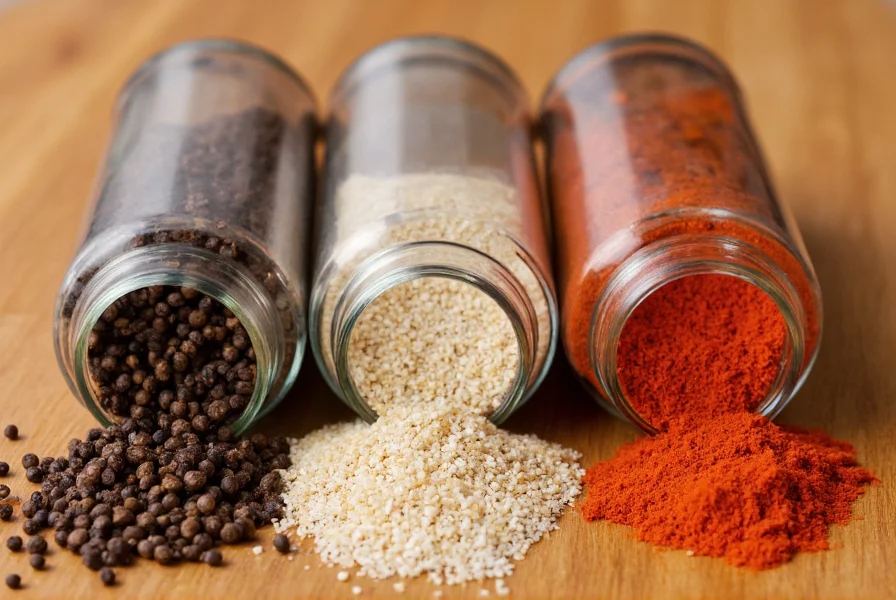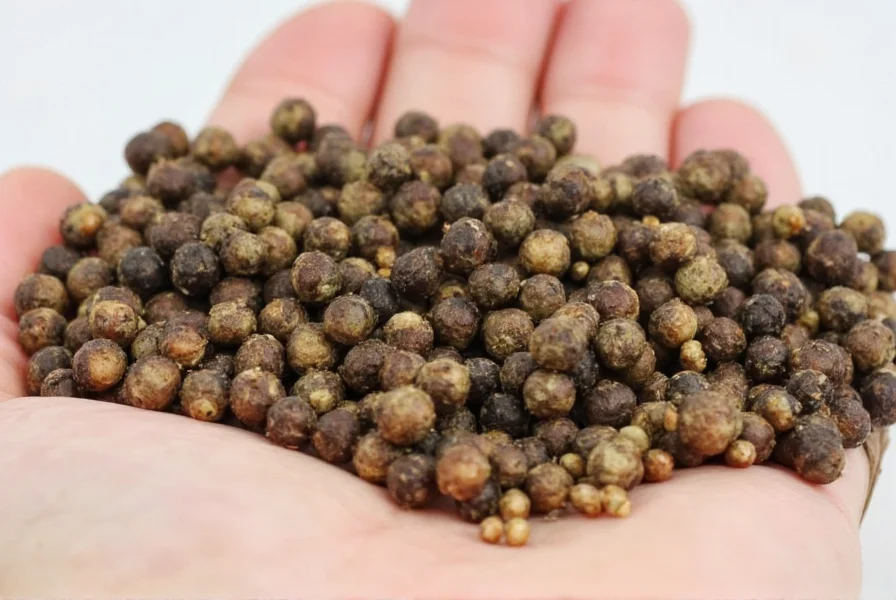Running out of black pepper mid-recipe creates immediate kitchen stress. Whether you're preparing a delicate cream sauce where black specks would ruin presentation, accommodating dietary restrictions, or simply emptying your spice rack, knowing reliable alternatives keeps your cooking on track. This guide delivers practical black pepper replacement solutions backed by culinary science, not just random suggestions.
Why Black Pepper Matters in Cooking
Black pepper isn't just a heat source—its complex flavor profile contains over 60 compounds that add subtle floral, woody, and citrus notes to dishes. The piperine compound provides its signature bite, while volatile oils contribute aromatic complexity. When seeking black pepper substitute for cooking, you're actually looking to replicate one or more of these elements depending on your dish.

Top 7 Black Pepper Substitutes Ranked by Use Case
| Substitute | Best For | Ratio vs Black Pepper | Flavor Notes |
|---|---|---|---|
| White pepper | Light-colored sauces, mashed potatoes | 1:1 | Sharper heat, earthier, less complex |
| Cayenne pepper | Spicy dishes, chili, hearty stews | 1/4:1 | Intense heat, minimal complexity |
| Sweet paprika | Meat rubs, soups, mild dishes | 1.5:1 | Earthy, slightly sweet, minimal heat |
| Allspice | Stews, braises, baked goods | 1/2:1 | Clove-cinnamon notes, warm complexity |
| Coriander | Fish, vegetables, dietary restrictions | 1.5:1 | Citrusy, floral, mild heat |
| Red pepper flakes | Pizza, pasta, robust dishes | 1/2:1 | Variable heat, textural element |
| Five-spice powder | Asian cuisine, roasted meats | 3/4:1 | Complex sweet-savory profile |
Specialized Substitution Strategies
For Light-Colored Dishes (The White Pepper Advantage)
When preparing alfredo sauce, potato salad, or any pale dish where black specks would be visually disruptive, white pepper becomes your best black pepper replacement in recipes. Made from the same plant but with outer layer removed, it delivers similar heat without the visual distraction. Use it at a 1:1 ratio, but note it has a slightly sharper, more earthy profile. For cream-based soups, add white pepper at the end of cooking to preserve its volatile compounds.
Dietary-Friendly Alternatives
For those with pepper allergies or following low-FODMAP diets, consider these black pepper alternatives for light-colored dishes:
- Coriander-cumin blend: Mix equal parts for earthy complexity without nightshade ingredients
- Mustard powder-ginger combo: Creates similar pungency (use 3/4 tsp mustard + 1/4 tsp ginger per 1 tsp black pepper)
- Asafoetida (hing): Use tiny amounts (1/8 tsp) in Indian dishes for comparable depth
Heat-Intensive Cooking Applications
When blackening meats or high-heat searing, black pepper's delicate compounds burn easily. For these scenarios, what to use instead of black pepper becomes a matter of timing and substitution:
- Add regular black pepper after cooking for maximum flavor
- Use cayenne during cooking (it withstands high heat better), then finish with a pinch of black pepper
- Create a post-cooking finishing salt with 1 part black pepper to 3 parts flaky sea salt
Avoid These Common Substitution Mistakes
Many home cooks make critical errors when implementing black pepper replacement strategies:
- Misjudging heat levels: Cayenne is significantly hotter than black pepper—always start with 1/4 the amount
- Ignoring dish acidity: In tomato-based sauces, reduce substitute amounts by 20% as acidity amplifies perceived heat
- Overlooking texture: Ground substitutes work differently than cracked pepper in finishing applications
- Adding too early: Most pepper substitutes lose complexity when cooked too long—add in final 5 minutes

Creating Custom Pepper Blends
For consistent black pepper substitute for cooking across multiple recipes, develop your signature blend:
Basic All-Purpose Substitute
Mix 2 tbsp white pepper, 1 tbsp paprika, 1 tsp garlic powder, and 1/2 tsp coriander. Store in airtight container. Use at 1:1 ratio. This versatile blend works for 90% of savory dishes requiring black pepper replacement.
Diet-Sensitive Alternative
Combine 3 tbsp coriander, 1 tbsp mustard powder, 2 tsp ginger, and 1 tsp celery seed. Ideal for those avoiding nightshades while maintaining complexity. Use at 1.5:1 ratio (1.5 tsp blend per 1 tsp black pepper).
When Substitution Isn't Enough
Some dishes fundamentally require black pepper's unique chemistry. In these cases, consider these solutions rather than inadequate black pepper replacement:
- Peppercorn infusion: Steep 1 tsp peppercorns in warm cream or stock for 10 minutes, then strain
- Pepper oil: Create by heating 1/4 cup oil with 2 tsp peppercorns for 5 minutes (cool before using)
- Emergency solution: Mix 1/2 tsp mustard powder with 1/4 tsp ginger and pinch of salt for immediate use
Final Recommendations
The most successful black pepper replacement strategy depends on understanding what element you're trying to replicate—heat, complexity, or visual presentation. Keep white pepper for light dishes, maintain a custom blend for everyday use, and remember that sometimes finishing with actual black pepper (added after cooking) solves the problem better than substitution. For dietary restrictions, coriander-based alternatives provide the safest black pepper alternatives for light-colored dishes without compromising flavor integrity.
Frequently Asked Questions
Can I use white pepper instead of black pepper in all recipes?
White pepper works well in light-colored dishes like cream sauces and mashed potatoes at a 1:1 ratio, but lacks the complex flavor notes of black pepper in most other applications. It provides similar heat with a sharper, more earthy profile. For best results, use white pepper primarily when visual presentation matters most.
What's the best black pepper substitute for someone with a pepper allergy?
For pepper allergies, try a blend of equal parts coriander and mustard powder. Coriander provides citrusy notes while mustard powder delivers mild pungency. Use 1.5 teaspoons of this blend per teaspoon of black pepper required. This creates a safe black pepper alternative that works particularly well in light-colored dishes.
How much cayenne should I use as a black pepper replacement?
Use only 1/4 teaspoon of cayenne for every 1 teaspoon of black pepper required. Cayenne delivers significantly more heat but lacks black pepper's complex flavor profile. Always start with less and adjust to taste, especially in delicate dishes. For most recipes, this ratio provides comparable heat without overwhelming the dish.
Does paprika work as a black pepper substitute?
Sweet paprika works as a mild black pepper replacement at a 1.5:1 ratio (1.5 tsp paprika per 1 tsp black pepper), providing earthy notes without significant heat. It's best for dishes where you want flavor complexity without spiciness, like meat rubs or soups. Avoid hot paprika unless you specifically want increased heat in your black pepper replacement strategy.
Why does my black pepper substitute taste different in soups?
Liquid-based dishes like soups amplify certain flavor compounds in pepper substitutes. Acidity from tomatoes or wine increases perceived heat, while prolonged cooking diminishes volatile compounds. For soups, reduce substitute amounts by 20% and add during the last 5 minutes of cooking to preserve flavor integrity when using black pepper replacement.











 浙公网安备
33010002000092号
浙公网安备
33010002000092号 浙B2-20120091-4
浙B2-20120091-4